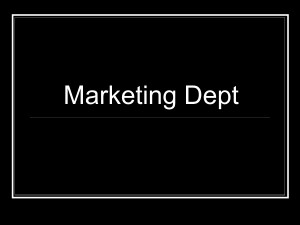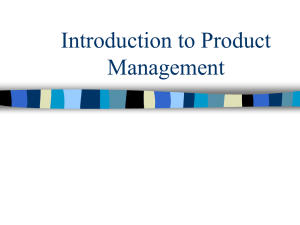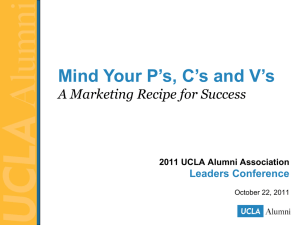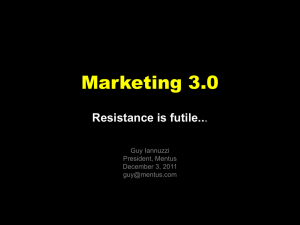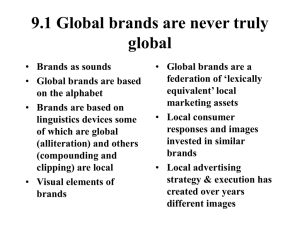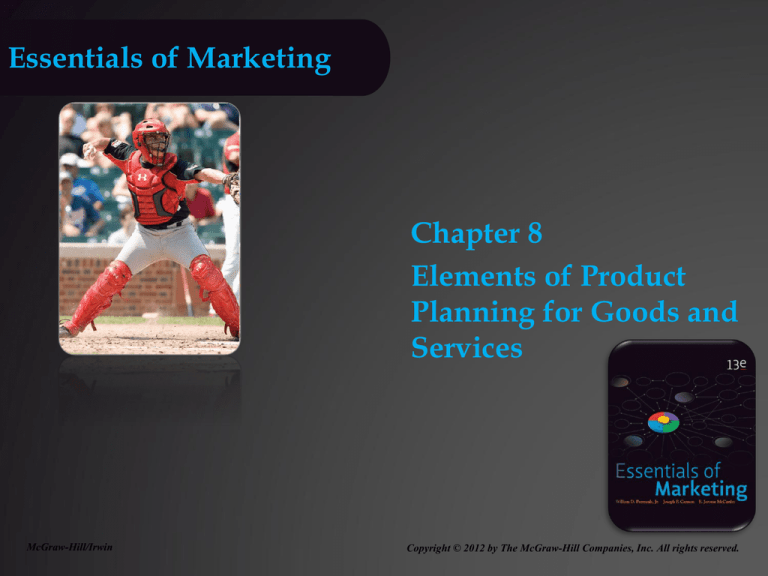
Essentials of Marketing
Chapter 8
Elements of Product
Planning for Goods and
Services
McGraw-Hill/Irwin
Copyright © 2012 by The McGraw-Hill Companies, Inc. All rights reserved.
At the end of this presentation, you should
be able to:
1.
Understand what “Product” really means.
2.
Know the key differences between goods and
services.
3.
Understand what branding is and how to use it in
strategy planning.
4.
Understand the importance of packaging in strategy
planning.
5.
Understand the role of warranties in strategy
planning.
8–2
At the end of this presentation, you should
be able to:
6.
Know the differences among various consumer and
business product classes.
7.
Understand how product classes can help a
marketing manager plan marketing strategies.
8.
Understand important new terms.
8–3
Product Decisions for Marketing Strategy
Planning (Exhibit 8-1)
8–4
Product Decisions for Marketing Strategy
Planning (Exhibit 8-1)
Chapter 8
Elements of
Product Planning
for Goods &
Services
Product
idea
Branding
Chapter 9
Product
Management &
New-Product
Development
Packaging
Warranty
Product
classes
8–5
Product
Quality and
Customer
Needs
8–6
Relative
Quality
8–7
Examples of Possible Blends of Physical Goods
and Services in a Product (Exhibit 8-2)
Canned soup,
steel pipe,
paper towels
100%
physical
good
emphasis
Restaurant
meal, cell
phone,
automobile
tune-up
Satellite radio,
hair styling,
postal service
100%
service
emphasis
Blend of
physical
good and
service
8–8
Differences
in Goods and
Services
8–9
Whole Product
Lines Must Be
Developed Too
8–10
Product Assortment, Product Line, or
Individual Product?
8–11
Recognized Trademarks and Symbols Help
in Promotion (Exhibit 8-3)
8–12
Conditions Favorable to Branding
Product
quality and
best value
Easy to label
and identify
Dependable,
widespread
availability
Key
Issues
Favorable
shelf or
display space
Market price
can be high
Economies of
scale
8–13
Achieving Brand Familiarity Is Not Easy
Brand
Insistence
Brand
Preference
Brand
Recognition
Brand NonRecognition
Brand Rejection
8–14
Brand
Familiarity
8–15
The Right Brand Name Can Help (Exhibit 8-4)
Short & Simple
Easy to Spell & Read
Easy to Recognize & Remember
Easy to Pronounce
Can Pronounce in Only One Way
Can Pronounce in All Languages
Suggests Product Benefits
Adapts to Packaging/Labeling Needs
No Undesirable Imagery
Always Timely
Adapts to Any Advertising Medium
Legally Available for Use
8–16
A Good Brand Name?
8–17
Protecting Brand Names & Trademarks
Lanham Act
You Must Protect
Your Own
Counterfeiting Is Accepted
In Some Cultures
8–18
What Kind of Brand to Use?
Licensed
Brand
Family Brand
Brand
Choices
Generic
“Brand”
Individual
Brand
8–19
Licensing
8–20
Who Should Do the Branding?
Manufacturer
Brands
Dealer Brands
• Also called national
brands
• Also called private
brands or private
labels
• Created/owned by
producers
Battle
of the
Brands
• Created/owned by
intermediaries
8–21
Checking Your Knowledge
Target’s “Cherokee” brand of men’s clothing is available only
at Target stores. The brand provides a low-cost alternative to
other men’s fashions available at department stores and via
catalogs. The Cherokee brand is a(n):
A.
B.
C.
D.
E.
manufacturer brand.
dealer brand.
licensed brand.
national brand.
generic brand.
8–22
The Strategic Importance of Packaging
Packaging Can
Enhance the
Product
Packaging Sends
a Message
UPC Codes
Speed Handling
Packaging Can
Lower
Distribution Costs
8–23
Ways Packaging Benefits Consumers and
Marketers
Protecting
Promoting
Enhancing
Benefits
8–24
What Is Socially Responsible Packaging?
Federal Fair
Packaging and
Labeling Act
Ethical
Decisions
Remain
Packaging
Can Hurt
Environment
Socially
Responsible
Packaging
Issues
8–25
Checking Your Knowledge
Heinz has a new ketchup bottle that has the cap on the
bottom, instead of the top. The bottle uses gravity to help the
consumer get every last drop of ketchup out of the bottle. The
cap is also designed to pour cleanly, so that dried ketchup
does not accumulate around the opening. This new bottle
demonstrates how packaging can:
A. promote product.
B. protect the product.
C. lower distribution costs.
D. incorporate UP codes.
E. enhance product usage.
8–26
Warranty Policies Are a Part of Strategy
Planning
Promises in
Writing
Service
Guarantees
MagnusonMoss Act
May Improve
Marketing Mix
8–27
Checking Your Knowledge
McDonald’s announced that at select locations, if drive-through
customers do not get exactly what they want within two minutes
of placing the order, their next meal will be free. This promise by
McDonald’s is a good example of a(n):
A.
B.
C.
D.
E.
service guarantee.
warranty.
unit price.
limited warranty.
no-fault insurance policy.
8–28
Product Classes Help Plan Marketing
Strategies
Consumer Products
Business Products
8–29
Consumer Product Classes
Staples
Convenience Products
Impulse
Emergency
Homogeneous
Shopping Products
Heterogeneous
Specialty Products
New Unsought
Unsought Products
Regularly Unsought
8–30
One Product May Be Seen in Several Ways
8–31
Classifying consumer products
Ingrid Stevenson decided to take her boyfriend to a “water amusement park”
as a birthday present. She also wanted to take pictures so that he’d
remember the day, but didn’t want her expensive digital camera to get
wet near the pools, slides, and water rides. So, she decided she would
also give him a disposable camera at the start of the day--although she
didn’t want to spend more than $20 on top of what the park tickets cost.
Ingrid didn’t know much about disposable cameras, but she went in the
University Camera Shop and asked the salesperson for advice about what
to buy that would meet her budget, make pictures of reasonable quality,
and hopefully work in the water. He recommended that she buy a
waterproof Kodak model that came with high speed film and would even
work for underwater shots.
Homogeneous
Staples
Shopping Products
New Unsought
Products
Heterogeneous
Impulse Products
Shopping Products
Regular Unsought
Products
Emergency Products
Specialty Products
8–32
Classifying consumer products
Jeremy Bower walked into a CVS drugstore and told the clerk at the
camera counter that he wanted to buy a disposable camera with a
built-in flash. The clerk said the store carried several such
cameras, including ones with the Kodak, Fuji, and CVS brands. "I'll
take the one with the lowest price," Jeremy told the clerk.
Staples
Homogeneous
Shopping Products
Impulse Products
Heterogeneous
Shopping Products
Emergency Products
Specialty Products
New Unsought
Products
Regular Unsought
Products
8–33
Classifying consumer products
Dawn Brady was at her cousin's house and saw some photographs that her
cousin had taken with a Kodak disposable camera. She was so surprised by
the quality of the pictures that she decided to purchase the same camera.
The next day she went to a nearby camera store and found that the store
did not have the Kodak in stock--although it did have other brands in stock
at about the same price. The salesperson in the store assured her that the
others were just as good. But Dawn ignored this advice and tried two other
stores that were also out of stock. Getting frustrated, Dawn was ready to
drive across town to a Target store. However, when she stopped for gas at
a convenience store, she came upon a display of Kodak disposable
cameras. She quickly bought one--even though she felt the price would be
lower at Target.
Homogeneous
Staples
Shopping Products
New Unsought
Products
Heterogeneous
Impulse Products
Shopping Products
Regular Unsought
Products
Emergency Products
Specialty Products
8–34
Classifying consumer products
While deep-sea fishing off the coast of Hawaii, Toby Rosso caught a
large swordfish. He decided that his friends back home would never
believe his "fish story" if he didn't have pictures. But he did not
have a camera. As soon as the boat got back to the dock, Toby
went to a nearby tourist shop. He was pleased to see a display of
Kodak disposable cameras, but was sorry to see a much higher price
than the same camera sold for in his hometown. He bought one
anyway, because he wanted to take some pictures right away
before the fish was taken away to the fish market.
Staples
Homogeneous
Shopping Products
Impulse Products
Heterogeneous
Shopping Products
Emergency Products
Specialty Products
New Unsought
Products
Regular Unsought
Products
8–35
Classifying consumer products
Wesley Pierce teaches high school science courses. He spends most of
his leisure time doing amateur photography. In fact, he enjoys
photography so much that for several years he has volunteered to
teach the advanced photography workshop offered by the city
recreation department. He has won several awards for his
photographs of mountain landscapes. Wesley has even earned extra
cash by selling some of his photos to companies that print
postcards. Several of his friends have encouraged him to turn
professional, but he prefers using his talents mainly as a hobby.
Staples
Homogeneous
Shopping Products
Impulse Products
Heterogeneous
Shopping Products
Emergency Products
Specialty Products
New Unsought
Products
Regular Unsought
Products
8–36
Classifying consumer products
While Hope Jekubovich was shopping in her local supermarket, she
came upon an end-of-aisle display with several different types of
Kodak disposable cameras. At first, she doubted the product quality
because the cameras all had plastic lenses. But remembering the
Kodak advertisements she had seen on television and in magazines,
she decided to buy one so that her grandchildren, who were visiting
for the week, could take pictures during their stay.
Staples
Homogeneous
Shopping Products
Impulse Products
Heterogeneous
Shopping Products
Emergency Products
Specialty Products
New Unsought
Products
Regular Unsought
Products
8–37
Checking Your Knowledge
Jack White wanted to purchase a new dress shirt. He went to a
local department store, toured the men’s department, and
thought all the brands looked about the same. He decided to
buy the store brand shirt, because it was the cheapest. For
Jack, the new shirt was a(n):
A.
B.
C.
D.
E.
convenience product.
heterogeneous shopping product.
specialty product.
homogeneous shopping product.
impulse product.
8–38
Business Products Are Different
Derived Demand
Inelastic Industry Demand
Tax Treatments Differ
8–39
Business Product Classes – How They Are
Defined
Accessories
Raw Materials
Installations
Professional
Services
Business
Product
Classes
Component
Parts &
Materials
MRO Supplies
8–40
Interactive Exercise: Business Product
Classes
8–41
You should now be able to:
1.
Understand what “Product” really means.
2.
Know the key differences between goods and
services.
3.
Understand what branding is and how to use it in
strategy planning.
4.
Understand the importance of packaging in strategy
planning.
5.
Understand the role of warranties in strategy
planning.
8–42
You should now be able to:
6.
Know the differences among various consumer and
business product classes.
7.
Understand how product classes can help a
marketing manager plan marketing strategies.
8.
Understand important new terms.
8–43
Key Terms
Product
Quality
Product assortment
Product line
Individual product
Branding
Brand name
Trademark
Service mark
Brand familiarity
Brand rejection
Brand nonrecognition
Brand recognition
Brand preference
Brand insistence
Brand equity
Lanham Act
8–44
Key Terms
Family brand
Licensed brand
Individual brands
Generic products
Manufacturer brands
Dealer brands
Private brands
Battle of the brands
Packaging
Universal product code
(UPC)
Federal Fair Packaging and
Labeling Act
Warranty
Magnuson-Moss Act
Consumer products
Business products
Convenience products
Staples
Impulse products
8–45
Key Terms
Emergency products
Shopping products
Homogeneous shopping
products
Heterogeneous shopping
products
Specialty products
Unsought products
New unsought products
Regularly unsought
products
Derived demand
Expense item
Capital item
Installations
Accessories
Raw materials
Farm products
Natural products
Components
Supplies
Professional services
8–46


